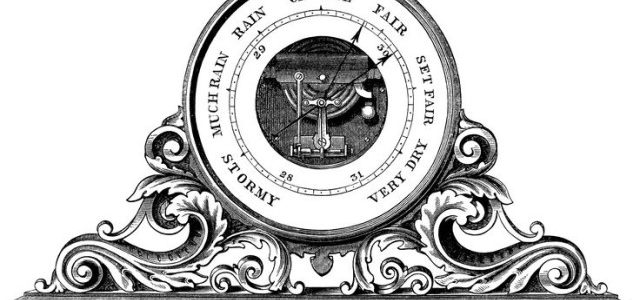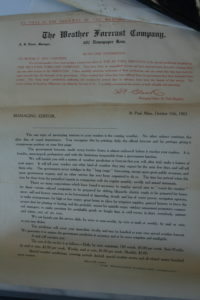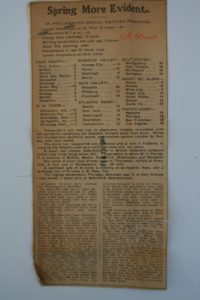

Tagged: environmental history, Gilded Age, Progressive Era, weather
In October 1903, the Weather Forecast Company of St. Paul, Minnesota, printed a testimonial from the editor of the St. Paul Dispatch endorsing the company’s predictions as “an unqualified success” and the newspaper’s most popular feature.[1] The Dispatch, which claimed to be the only newspaper west of the Atlantic coast to have its own commercial weather service, introduced the forecasts in 1903 especially for farmers in “the greatest crop region in the world.”[2] The Weather Forecast Company—like the Weather Channel, Accuweather, and hundreds of private forecasters in the twenty-first century—relied on advertising like this circular to generate demand for various customized products, including daily telegraphed forecasts, semi-weekly and weekly forecasts by mail or telegraph, and monthly forecasts. 
But the Weather Forecast Company was far more controversial than the myriad weather forecasting companies that are a mundane presence in our lives today. The history of the Weather Forecast Company illuminates the contests over the production of meteorological knowledge during a time when almanacs, private long-range and short-term forecasters, and the federal government all competed for the attention and trust of a public increasingly eager for yet increasingly skeptical of weather forecasts.[3]
The company’s manager, Alton D. Elmer, offered a free trial to newspaper editors, promising local forecasts more timely and accurate than the federal government’s daily forecast, which Elmer derided as “stereotyped, perfunctory and with the limitations inseparable from a government function.”[4]  ] Claiming a verification percentage often higher than the government’s, Elmer marketed his forecasts to a range of businesses including railroad and shipping companies, farmers and manufacturers, and outdoor amusement venues. The Weather Forecast Company’s biggest selling point was its three-day forecasts, since the government weather service did not yet regularly issue forecasts beyond forty-eight hours. At the turn of the twentieth century, the U.S. Weather Bureau adhered to the more conservative and reliable short-term forecasts that the federal government first issued in 1871.[5] Long-range forecasting, according to government weather scientists, was a pernicious fraud no better than patent-medicine quackery.
] Claiming a verification percentage often higher than the government’s, Elmer marketed his forecasts to a range of businesses including railroad and shipping companies, farmers and manufacturers, and outdoor amusement venues. The Weather Forecast Company’s biggest selling point was its three-day forecasts, since the government weather service did not yet regularly issue forecasts beyond forty-eight hours. At the turn of the twentieth century, the U.S. Weather Bureau adhered to the more conservative and reliable short-term forecasts that the federal government first issued in 1871.[5] Long-range forecasting, according to government weather scientists, was a pernicious fraud no better than patent-medicine quackery.
Elmer quickly came to the attention of government officials, who sought to drive long-range forecasters out of business and strengthen their agency’s professional reputation. Weather Bureau personnel in Washington, D.C., and Minnesota investigated Elmer, as they had dozens of others, but were frustrated by the proliferation of “long-rangers” who operated lucrative subscription services and garnered public acclaim for every forecast they got right and government forecasters got wrong. Upon learning of Elmer in March 1904, Willis L. Moore, who led the battle against the long-rangers during his leadership of the Weather Bureau from 1895 to 1913, admitted, “I am at a loss to know how to defend the public against the work of long-range forecasters.”[6]
Yet in many respects the Weather Forecast Company did not fit neatly into the dichotomy of government science vs. amateurish superstition (or outright fraud) perpetuated by government officials and journalists at the turn of the century. First, Elmer was a relatively modest long-ranger: his regular three-day and monthly predictions did not extend as far as the seasonal or yearly forecasts available in almanacs and from the well-known commercial forecasters targeted by the Weather Bureau. Moreover, Elmer’s forecasting method was considered more credible than the theories of planetary meteorology, electromagnetic disturbances, and sunspot cycles that governed the work of other “weather prophets”: the forecasts Elmer produced for the evening edition of the St. Paul Dispatch had an empirical basis in the Weather Bureau’s morning weather map, which was produced from standardized observations of temperature, precipitation, and barometric pressure telegraphed by a nationwide network of government observers.[7]
Unlike the long-rangers that Moore labeled frauds, Elmer received an apology from the government’s head meteorologist, Cleveland Abbe, who deemed Elmer “an honest long-range forecaster.” Abbe regretted including Elmer in the Monthly Weather Review’s July 1904 list of “fake forecasters,” allowing that Elmer had contributed to meteorological science and used the government weather map responsibly, but had unfortunately been enticed to sometimes issue unscientific long-range forecasts. Printed below Abbe’s apology was a letter in which Elmer denounced long-range forecasting as “humbuggery” and revealed that he only opened his own forecasting business because he was ineligible to join the Weather Bureau, having exceeded the age limit for new personnel. Elmer concluded that long-range forecasting was “impracticable unless mixed with guesswork, i.e., lying.” Elmer’s letter, which enumerated twelve points intended to restore his reputation, blamed pressure from newspaper editors seeking “sensational predictions,” which he ultimately rejected out of his moral unwillingness to “sacrifice honor for profit.”[8] On one hand, the Monthly Weather Review’s list of “fake forecasters” was a product of late nineteenth-century professionalization by government meteorologists who defined themselves in opposition to alleged frauds. But it also fit into a history of Progressive Era regulation in which weather forecasts–alongside the more familiar examples of postal matter, patent medicines, and adulterated agricultural commodities–came under the scrutiny of expanded federal authority targeting commercial fraud. Elmer’s vindication after disavowing long-range forecasting is analogous to the “bureaucratic paternalism” that Edward J. Balleisen has identified in turn-of-the-century federal and state anti-fraud regulation.[9]
The Weather Forecast Company was a short-lived venture, as Elmer returned to his native Northfield, Massachusetts, by the end of 1904 to live with his parents and follow in his father’s footsteps as a drug salesman. After the death of his wife, Elmer was living in a Boston boarding house in 1920 and working as an elevator operator in 1930, having left St. Paul and his weather forecasting business far behind.[10] But the brief history of the Weather Forecast Company is significant as an example of the booming business in late nineteenth- and early twentieth-century forecasting that encompassed not only the weather, but also the harvest, the market, and the promises of love and money sold by fortune-tellers. Elmer’s story highlights the instability of retrospectively imposed boundaries between science and fraud and between professional expertise and vernacular knowledge, boundaries that were nonetheless deployed as rhetorical weapons by myriad public and private forecasters vying for authority in the marketplace. Finally, Alton D. Elmer’s Weather Forecast Company offers a glimpse into a lively and controversial “culture of prediction” and calls attention to forecasting as an important yet little-studied aspect of science, capitalism, and culture in the Gilded Age and Progressive Era.[11]
Dr. Jamie Pietruska, Assistant Professor of History at Rutgers University, is a historian of culture, technoscience, capitalism, and bureaucracy. Her scholarship examines the production and circulation of knowledge in the nineteenth- and early twentieth-century United States. Her first book, Looking Forward: Prediction and Uncertainty in Modern America (University of Chicago Press, 2017), is a history of forecasting that explores how the routinized predictions of everyday life functioned as tools for risk management as late nineteenth- and early twentieth-century Americans came to believe in the promise and accept the limitations of predicting the future. Her current research explores paperwork, bureaucracy, and investigation in the nineteenth- and early twentieth-century United States
[1] The Weather Forecast Company, circular, October 15, 1903, box 1787, Letters Received, 1896-1912, Records of the Weather Bureau, Record Group 27, NARA II.
[2] Report of the Dispatch Weather Bureau for 9 Months of the Meteorological Year, ending Feb. 29, 1904, box 1787, Letters Received, 1896-1912, RG 27, NARA II. On rural access to weather forecasts in the late nineteenth century, see Jamie L. Pietruska, Looking Forward: Prediction and Uncertainty in Modern America (Chicago: University of Chicago Press, 2017), ch. 2.
[3] The sheer number and variety of weather forecasts in this period is noteworthy. In addition to the Old Farmer’s Almanac (est. 1792) and Farmers’ Almanac (est. 1818), both of which are still produced today, readers could consult hundreds of other regional almanacs, nationally-known almanacs that focused solely on the weather, and tens of millions of copies of patent medicine advertising almanacs that circulated each year in the early twentieth century. Private forecasters commonly sold subscriptions to newspapers, which also printed the official daily forecast from the federal government. Individual readers often consulted multiple forecasts and sometimes wondered who had the authority and the ability to make a scientific weather prediction. On the epistemic debates over these competing and overlapping systems of meteorological knowledge production, see Pietruska, Looking Forward, chs. 2 and 3.
[4] The Weather Forecast Company, circular, October 15, 1903, box 1787, Letters Received, 1896-1912, RG 27, NARA II.
[5] The national weather service was first housed in the U.S. Army Signal Service (1870-1891) and subsequently transferred to civilian oversight in the U.S. Department of Agriculture (1891-1940), the Department of Commerce (1940-1970), and the National Oceanic and Atmospheric Administration (1970-present). On the military origins of the weather service, see James Rodger Fleming, “Storms, Strikes, and Surveillance: The U.S. Army Signal Office, 1861-1891,” Historical Studies in the Physical and Biological Sciences 30, no. 2 (2000): 315-32.
[6] Willis L. Moore to H. M. Watts, March 26, 1904, Box 1787, Letters Received, 1896-1912, Records of the Weather Bureau, RG 27, NARA II. On Moore’s crusade against long-range forecasters, see Jamie L. Pietruska, “U.S. Weather Bureau Chief Willis Moore and the Reimagination of Uncertainty in Long-Range Forecasting,” Environment and History 17 (2011): 79-105.
[7] On the production and significance of the daily weather map, see Mark Monmonier, Air Apparent: How Meteorologists Learned to Map, Predict, and Dramatize the Weather (University of Chicago Press, 1999). NOAA’s Central Library has a digitized collection of U.S. Daily Weather Maps from 1871 to 1968: https://library.noaa.gov/Collections/Digital-Collections/US-Daily-Weather-Maps.
[8] Cleveland Abbe, “An Honest Long-Range Forecaster,” Monthly Weather Review 32, no. 11 (November 1904): 517, https://books.google.com/books?id=5yAX7YMi5LQC&pg=PA517#v=onepage&q&f=false.
[9] Edward J. Balleisen, Fraud: An American History from Barnum to Madoff (Princeton University Press, 2017), 160. On federal scrutiny of weather forecasts, see Jamie L. Pietruska, “‘A Tornado is Coming!’: Counterfeiting and Commercializing Weather Forecasts from the Gilded Age to the New Era,” Journal of American History, forthcoming Dec. 2018.
[10] Massachusetts, Birth Records, 1840-1915, Ancestry.com; United States Federal Census of 1900, 1910, 1920, and 1930, all on Ancestry.com.
[11] On the “culture of prediction” in the Gilded Age and Progressive Era, see Pietruska, Looking Forward, 3.
Receive a year's subscription to our quarterly SHGAPE journal.